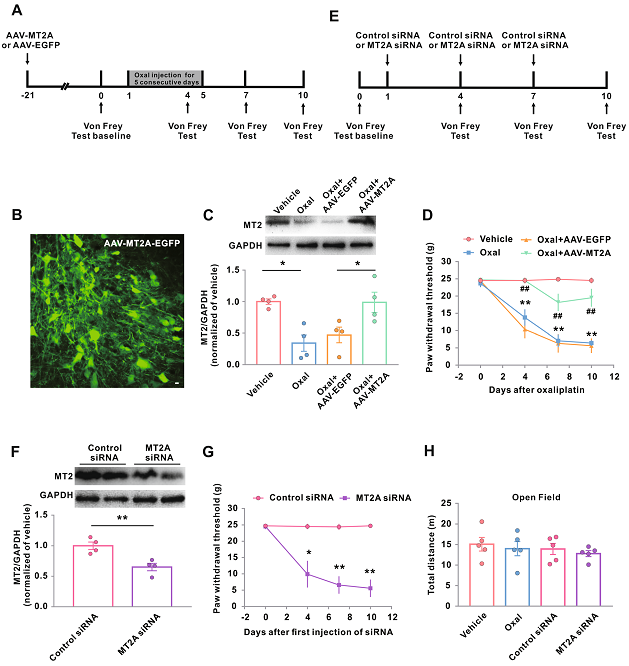AAV-MT2A was used for downregulation of MT2. (From
BrainVTA)
The viruses used in this article from BrainVTA are in the table below
|
Custom-Made AAVs |
AAV-hSyn-MT2A-EGFP |
|
Control |
rAAV-Ef1α-DIO-EGFP-WPRE-hGH polyA |
Xuelin Huang, Jie Deng, Ting Xu, Wenjun Xin, Yuehong Zhang, Xiangcai Ruan
Pub Date: 2020-12-13,
DOI: 10.1186/s12974-021-02139-6,
Email: sales@brainvta.com
Background: We previously reported a correlation between small doses of oxaliplatin penetrating onto the spinal cord and acute pain after chemotherapy. Here, we propose that MT2 within the spinal dorsal horns participates in the development of oxaliplatin-induced neuropathic pain and may be a pharmacological target for the prevention and treatment of chemotherapy-induced peripheral neuropathy (CIPN).
Methods: The rat model of CIPN was established by 5 consecutive injections of oxaliplatin (0.4 mg/100 g/day). Genetic restoration of neuron-specific metallothionein-2 was implemented 21 days before oxaliplatin treatment, and also, genetic inhibition by metallothionein-2 siRNA was performed. Mechanical allodynia and locomotor activity were assayed. Cell-specific expression of metallothionein-2, the mRNA levels of pro-inflammatory cytokines, nuclear translocation of NF-κB, the protein levels of expression of IκB-α, and interaction between IκB-α and P65 were evaluated in the spinal dorsal horns. Also, in vitro interaction of sequentially deleted IκB-α promoter with metallothionein-2 was used to assess the signal transduction mechanism.
Results: We found that oxaliplatin induced downregulation of metallothionein-2 in rat spinal cord neurons. By contrast, genetic restoration of metallothionein-2 in the spinal dorsal horn neuron blocked and reversed neuropathic pain in oxaliplatin-treated rats of both sexes, whereas genetic inhibition of metallothionein-2 triggered neuropathic pain in normal rats. Overall locomotor activity was not impaired after the genetic alterations of metallothionein-2. At the molecular level, metallothionein-2 modulated oxaliplatin-induced neuroinflammation, activation of NF-κB, and inactive transcriptional expression of IκB-α promoter, and these processes could be blocked by genetic restoration of metallothionein-2 in the spinal dorsal horn neurons.
Conclusions: Metallothionein-2 is a potential target for the prevention and treatment of CIPN. A reduction of NF-κB activation and inflammatory responses by enhancing the transcription of IκB-α promoter is proposed in the mechanism.
 Figure 1. Impact of genetic modification of MT2 on Oxal-induced neuropathic pain.
Figure 1. Impact of genetic modification of MT2 on Oxal-induced neuropathic pain.
This study is aimed to explore the mechanism of chemotherapy-induced peripheral neuropathy (CIPN). The authors investigate the role of MT2, encoded by the MT2A gene in CIPN. The results show that MT2 participates in the painful CNS effects of oxaliplatin and may be a pharmacological target for the prevention and treatment of oxaliplatin-associated neurotoxicity.
BrainVTA offers viral vector construction & virus packaging services for AAV, LV, RABV, PRV, HSV and VSV that help researchers explore questions about genes, neurons, circuitry structure, function of brain network, mechanism and treatment of diseases.
If you have any needs, just email us at
sales@brainvta.com.
